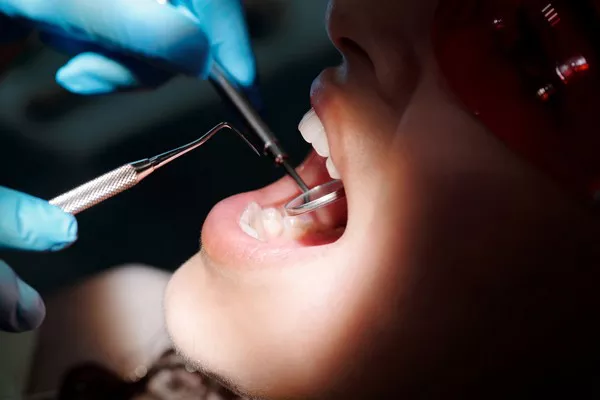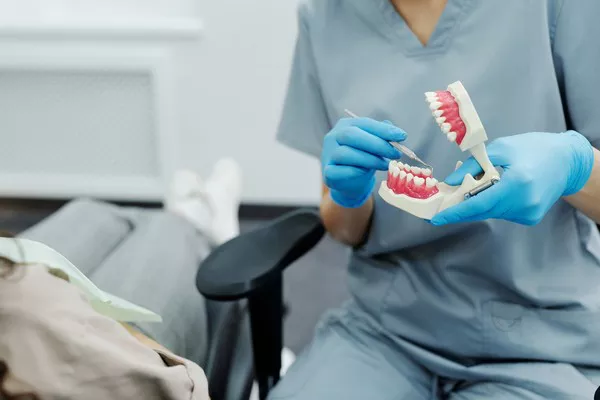Gingivitis and periodontitis are two common gum diseases that affect oral health. While gingivitis is reversible and primarily characterized by gum inflammation, periodontitis is a more advanced condition involving irreversible damage to the supporting structures of the teeth. Many individuals wonder about the timeline for the progression of gingivitis to periodontitis. This article aims to provide insights into the factors influencing this transition and shed light on the timeframe involved.
Understanding Gingivitis and Periodontitis
Gingivitis is the initial stage of gum disease and arises from the accumulation of plaque along the gumline. Plaque is a sticky film comprising bacteria and food particles that irritate the gums, leading to inflammation. Common symptoms include redness, swelling, tenderness, and bleeding of the gums.
If left untreated, gingivitis can progress to periodontitis. Unlike gingivitis, periodontitis involves not only gum inflammation but also damage to the deeper tissues supporting the teeth, including the bone and ligaments. As the disease advances, pockets form between the gums and teeth, harboring bacteria and exacerbating the destruction of the supporting structures. Gradually, teeth may become loose and eventually require extraction.
Factors Influencing the Progression
The timeframe for gingivitis to progress to periodontitis varies among individuals and depends on several key factors:
a) Oral Hygiene Practices:
Consistent and effective oral hygiene practices play a vital role in preventing the progression of gingivitis to periodontitis. Regular brushing, flossing, and professional dental cleanings help remove plaque and prevent its buildup along the gumline.
b) Frequency and Severity of Inflammation:
Individuals who experience frequent or severe episodes of gum inflammation due to gingivitis are more susceptible to the progression to periodontitis. Chronic inflammation can worsen the destruction of the underlying tissues.
c) Individual Immune Response:
The body’s immune response varies among individuals. Some people may have a heightened inflammatory response, which can accelerate the progression from gingivitis to periodontitis.
d) Genetic Predisposition:
Genetic factors can influence an individual’s susceptibility to gum disease. Certain gene variations may increase the risk of developing periodontitis, even with excellent oral hygiene practices.
e) Systemic Health Conditions:
Underlying health conditions such as diabetes, cardiovascular diseases, and immunodeficiency disorders can compromise the body’s ability to fight gum infections, thereby facilitating the transition from gingivitis to periodontitis.
f) Tobacco Use:
Smoking and tobacco use are significant risk factors for gum disease progression. Tobacco products impair blood flow to the gums, hinder the healing process, and weaken the immune system, making it easier for bacteria to cause damage.
Timeframe for Progression :
The timeframe for gingivitis to develop into periodontitis is variable and depends on multiple factors, including those mentioned above. While it is challenging to provide an exact timeline, the following general progression pattern can be observed:
a) Early Gingivitis Stage:
Gingivitis typically develops within a few days to weeks of inadequate oral hygiene practices and plaque accumulation. At this stage, gum inflammation and bleeding may be noticeable, but the damage is still mainly limited to the superficial gum tissues.
b) Transition Phase:
If left untreated, gingivitis can progress to a more advanced stage within months to years, depending on various factors. During this transitional phase, the inflammation extends beyond the gumline, affecting the deeper tissues supporting the teeth. Pockets begin to form between the gums and teeth, providing an ideal environment for bacteria to thrive.
c) Established Periodontitis:
At this stage, the destruction of the supporting structures, including the bone and ligaments, becomes evident. The progression from gingivitis to established periodontitis can take several months to years, depending on the individual’s oral health practices, immune response, genetic predisposition, and presence of risk factors.
It is important to note that not all cases of gingivitis progress to periodontitis. With proper oral hygiene practices, regular dental check-ups, and timely intervention, gingivitis can be reversed or effectively managed, preventing further damage to the gums and supporting structures.
Prevention and Intervention Strategies
Prevention and intervention strategies are important approaches used to address a wide range of issues, from health and safety to social and behavioral challenges. Here are some common prevention and intervention strategies that can be applied in various contexts:
Education and Awareness:
Providing information and raising awareness about the issue at hand is crucial for prevention. This can include educating individuals, communities, or specific target groups about risks, consequences, and available resources.
Early Intervention:
Identifying and addressing problems at their early stages can prevent them from escalating into more serious issues. Early intervention involves timely identification, assessment, and targeted support for individuals or groups at risk.
Health Promotion:
Promoting healthy behaviors and lifestyles is an effective preventive strategy. This can involve encouraging regular exercise, proper nutrition, stress management, and other practices that contribute to overall well-being.
Policy Development:
Developing and implementing policies and regulations can help prevent negative outcomes by creating guidelines, standards, and legal frameworks. Policies can address a wide range of issues, such as public health, environmental protection, and social justice.
Community Engagement:
Engaging communities and involving stakeholders is essential for effective prevention and intervention efforts. Building partnerships, involving community leaders, and encouraging active participation can provide valuable insights and support.
Counseling and Therapy:
Providing counseling services and therapy can help individuals cope with and overcome personal challenges. These interventions aim to address emotional, psychological, or behavioral issues and promote positive change.
Skill Development:
Equipping individuals with the necessary skills and competencies can empower them to make informed decisions and handle challenges effectively. Skill development programs can focus on areas such as communication, problem-solving, conflict resolution, and decision-making.
Enforcement and Regulation:
Enforcing laws and regulations is important for preventing and addressing issues related to safety, public health, and compliance. This can involve monitoring and taking appropriate action against those who violate rules or engage in harmful activities.
Rehabilitation and Treatment:
For issues involving addiction, criminal behavior, or mental health disorders, rehabilitation and treatment programs play a vital role. These interventions aim to address the root causes of problems and support individuals in their journey towards recovery.
Research and Evaluation:
Continuous research and evaluation help in understanding the effectiveness of prevention and intervention strategies. By gathering data and analyzing outcomes, stakeholders can make informed decisions about adapting or improving existing approaches.
It’s important to note that the specific strategies employed will vary depending on the context and the issue being addressed. Additionally, a comprehensive approach often combines multiple strategies to achieve the best results.
Related Topics:





























